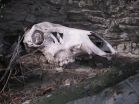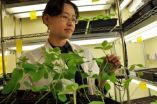(Press-News.org) By taking a closer look at animal bones scattered across the wilderness landscape, a researcher at the University of Chicago has found a powerful tool for showing how species' populations have changed over decades or even a century.
"The skeletons of long-dead animals lying on landscapes provide critical insight into our understanding of ecosystem history, especially how populations have changed," said the study's author, University of Chicago alumnus Joshua H. Miller, S.M.'05, PhD'09, a postdoctoral research fellow in biological sciences at Wright State University in Dayton, Ohio.
The study, published in the March 28 issue of PLoS ONE, presents data that Miller collected for his UChicago doctoral dissertation. His study provides a deeper context for the many disturbances that are altering ecosystems around the world, including global warming, overharvesting and habitat destruction.
"These changes result in population reductions and extinctions of some species, while others expand and invade new habitats and regions," Miller explained. "Most ecosystems have not been studied over long time spans — many decades at least — which hampers the ability of wildlife managers and other scientists to properly document or mediate these dramatic ecological changes."
Surveying the bones of Yellowstone
In research funded by the National Science Foundation, Miller surveyed bones from the skeletons of hoofed mammals (ungulates) in Yellowstone National Park. The bones ranged in age from newly dead to approximately 200 years old.
Then he compared the numbers of specimens from each species documented in bones to surveys of the living populations.
Miller found that all the native species in the living community were recovered and that the order of species from most abundant to least abundant was similar for the bones and the living community. Species whose populations significantly diminished or expanded over the last 20 to 80 years were predictably over- or under-represented in the bones relative to the living community.
"Live elk were much more abundant in the 1990s than they are today," Miller said, "and the bones of Yellowstone feature far more elk than one would predict based on the current Yellowstone community."
Horses, which were replaced by cars as the dominant mode of transportation in Yellowstone in the early 1900s, also are readily found as skeletal remains. Radiocarbon dating confirmed that horse bones were generally remnants from when the cavalry controlled Yellowstone in the late 1800s to early 1900s.
In contrast to these ghosts of larger past populations, species that have recently increased in abundance (bison and the recently arrived mountain goat) are less common in the skeletal record than current living populations would predict. Overall, the bones of Yellowstone correlate well with the area's historical ecosystem and provide more detailed information about the historical community than can be acquired from only studying the ecosystem today.
"Bones provide a great tool for uncovering historical ecological data that allow us to put modern biodiversity in a broader temporal context," Miller said. "The living populations of Yellowstone have been studied for a long time and provide a great opportunity to test how well bones record species' histories. Now we can go the next step and use bone accumulations in regions we have only recently begun studying to obtain critical historical data and establish how ecosystems have changed over the last decades, century or even longer."
Miller's research also suggests that the ecological information contained in the fossil record may provide more biological details on extinct ecosystems than previously thought.
"Josh has shown that the bones of Yellowstone accurately track recent and not-so-recent history of the large mammal populations in this famous North American ecosystem," said Kay Behrensmeyer, curator of vertebrate paleontology of the Smithsonian Institution's National Museum of Natural History. "This should be a wake-up call for ecologists interested in the movements, increases and declines of large mammal populations anywhere — bones are a relatively untapped and valuable source of ecological data about animals when they were alive."
INFORMATION:
Miller received the 2008 Romer Prize in paleontology for the research, which was supervised by Susan Kidwell, UChicago's William Rainey Harper Professor in Geophysical Sciences.
Bones conjure Yellowstone's ecological ghosts
2011-03-29
ELSE PRESS RELEASES FROM THIS DATE:
AmeriSus Partners with HomeSphere
2011-03-29
Lakewood-based HomeSphere, Inc. announced today that they have entered into a partnership with the American Sustainability Initiative (AmeriSus) to effectively manage manufacturer rebates with their BRI and AllTrack applications.
Inspired by the Sears kit houses of the 1930s, AmeriSus manages all design, engineering, product and technology selections, procurement, logistics and scheduling for home builders, in order to deliver all materials necessary to construct an affordable, super-efficient homes for the end consumer. AmeriSus catalog homes are designed to fit into ...
Human virus linked to deaths of endangered mountain gorillas
2011-03-29
For the first time, a virus that causes respiratory disease in humans
has been linked to the deaths of wild mountain gorillas, reports a
team of researchers in the United States and Africa.
The finding confirms that serious diseases can pass from people to
these endangered animals.
The researchers are from the non-profit Mountain Gorilla Veterinary
Project; the Wildlife Health Center at the University of California,
Davis; the Center for Infection and Immunity at Columbia University;
and the Rwanda Development Board.
Their study, which reports the 2009 deaths ...
International Diabetes Federation supports surgery to treat diabetes
2011-03-29
NEW YORK (March 28, 2011) -- Bariatric surgery should be considered earlier in the treatment of eligible patients to help stem the serious complications that can result from diabetes, according to an International Diabetes Federation (IDF) position statement presented by leading experts at the 2nd World Congress on Interventional Therapies for Type 2 Diabetes in New York.
The statement was written by 20 leading experts in diabetes and bariatric surgery who have made a series of recommendations on the use of weight-loss surgery as a cost-effective treatment option for ...
Research proves no 2 of us are alike, even identical twins
2011-03-29
Just like snowflakes, no two people are alike, even if they're identical twins according to new genetic research from The University of Western Ontario. Molecular geneticist Shiva Singh has been working with psychiatrist Dr. Richard O'Reilly to determine the genetic sequencing of schizophrenia using identical or monozygotic twins. The study is published in this month's PLoS ONE.
Singh looked at about one million markers of identical twins (and their two parents) where only one twin had schizophrenia. "The most informative feature of schizophrenia is that it sometimes ...
How do plants fight disease?
2011-03-29
RIVERSIDE, Calif. – How exactly bacterial pathogens cause diseases in plants remains a mystery and continues to frustrate scientists working to solve this problem. Now Wenbo Ma, a young plant pathologist at the University of California, Riverside, has performed research on the soybean plant in the lab that makes major inroads into our understanding of plant-pathogen interactions, a rapidly developing area among the plant sciences.
Her breakthrough research can help scientists come up with effective strategies to treat crops that have succumbed to disease or, when used ...
Total Mortgage Services Receives District of Columbia Mortgage Lender License
2011-03-29
Total Mortgage Services, LLC, a leading mortgage lender, announced today that it has received its District of Columbia Mortgage Lender License from Department of Insurance, Securities and Banking and can now originate residential mortgage loans in the District of Columbia. Total Mortgage is licensed as a mortgage lender in District of Columbia and holds Mortgage Lender License NMLS2764.
"We are excited about now being able to help borrowers throughout Washington DC with their current purchase and refinancing needs," commented John Walsh, President of Total Mortgage. ...
MadCap Software Wins Patent for Structure Bar Technology in XML-based MadCap Flare Publishing Software
2011-03-29
MadCap Software, Inc. (http://www.madcapsoftware.com), the leader in multi-channel content authoring and a showcase company for Microsoft Visual Studio and Microsoft XPS, today announced that the United States Patent and Trademark Office has awarded MadCap a patent for its "Visual Document Structure Indicator" technology.
The patented design provides the basis of the Structure Bars in MadCap Flare, MadCap's flagship XML-based software for single-source multi-channel publishing, which give users unprecedented ease in creating and publishing structured content. Structure ...
Indications of Alzheimer's disease may be evident decades before first signs of cognitive impairment
2011-03-29
Researchers at Mount Sinai School of Medicine have found that patients with Alzheimer's disease have lower glucose utilization in the brain than those with normal cognitive function, and that those decreased levels may be detectable approximately 20 years prior to the first symptoms of Alzheimer's disease. This new finding could lead to the development of novel therapies to prevent the eventual onset of Alzheimer's. The study is published online in the journal Translational Neuroscience.
Using mice modified to develop Alzheimer's disease, the research team found that ...
Icebergs in the Antarctic play important role in carbon cycle
2011-03-29
Icebergs cool and dilute the ocean water they pass through and also affect the distribution carbon-dioxide-absorbing phytoplankton in the Southern Ocean, according to a team of researchers from UC San Diego and the University of San Diego.
The effects are likely to influence the growth of phytoplankton in the Atlantic sector of the Southern Ocean and especially in an area known as "Iceberg Alley" east of the Antarctic Peninsula.
Enhanced phytoplankton growth would increase the rate at which carbon dioxide is removed from the ocean, an important process in the carbon ...
Butterfly study reveals traits and genes associated with establishment of new populations
2011-03-29
A team of scientists has discovered that descendants of "exploratory" butterflies that colonized new habitats differ genetically from their more cautious cousins. The team, led by James Marden, a professor of biology at Penn State University, and Christopher Wheat, a post-doctoral scholar working at both Penn State and the University of Helsinki, has revealed some of the genetic bases for faster egg maturation, a higher rate of energy metabolism, and superior flight ability -- traits that provide an advantage to butterflies that stray from familiar territory to found new ...






